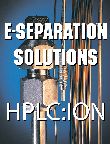Extraction and Analysis of Sulfonamides from Honey by LC-MS-MS using strata X-C Polymeric SPE Sorbent and Gemini C18 HPLC Column
American and European Foulbrood in honeybees is caused by two bacterial species, Paenibacillus larvae and Melissococcus pluton, respectively. For control of these bacteria, only a few antibiotics are recommended in Europe and the U.S.A. However, a variety of antibacterial agents are used, the sulfa drugs being the most popular. Residues of these antibiotics are quite often found in honey samples and are of concern to consumers around the world due to toxic or allergic reactions. Earlier sample preparation methods involved using silica-based C18 or neutral polymers as sorbents with an aqueous wash prior to elution of sulfonamides. In this communication, we describe a simple and effective method for cleanup and quantitation of antibacterial sulfonamides from honey using the polymeric strong cation exchange SPE sorbent strata-X-C and a Gemini HPLC column.

Analytical Challenges in Measuring Migration from Food Contact Materials
November 2nd 2015Food contact materials contain low molecular weight additives and processing aids which can migrate into foods leading to trace levels of contamination. Food safety is ensured through regulations, comprising compositional controls and migration limits, which present a significant analytical challenge to the food industry to ensure compliance and demonstrate due diligence. Of the various analytical approaches, LC-MS/MS has proved to be an essential tool in monitoring migration of target compounds into foods, and more sophisticated approaches such as LC-high resolution MS (Orbitrap) are being increasingly used for untargeted analysis to monitor non-intentionally added substances. This podcast will provide an overview to this area, illustrated with various applications showing current approaches being employed.




